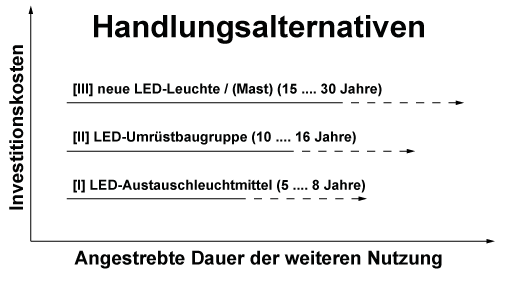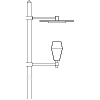Overview
Cities, communities, municipalities and utilities face the challenge of investing in energy-saving technologies in times of rising energy prices and heavily burdened households. It is clear from a technical as well as an economic point of view: The future of lighting belongs to LED technology.
The question now is: which migration scenarios are sensible and technically and economically sustainable? Depending on the type, purpose and condition of the luminaire stock, there is a range of options for the operators of outdoor lighting systems: These range from the replacement of complete luminaires / masts [III] (worn equipment) to the retrofitting / conversion of survivable existing luminaires with a long-term horizon [II] to the use of LED replacement luminaires [I] with a short to medium-term utilization horizon.

| Application | Feature | Focus | Example |
|---|---|---|---|
| Roads | Medium to big power high points of light> 6m decided light distribution characteristic long life, robust easy to maintain | usually close relation to relevant lighting standards | Case lights |
| Residential streets, paths | Small power Points of light between 4…5m often "all-round" durable and cost-effective | Decorative appearance, moderate purchase price | Screen-, mushroom-, cylinder- and bells lights |
| Inner-city, historical areas, courts | Small to medium power Points of light between 4 ... 8m often omnidirectional higher price segments, partly custom made | Instrument of the city and Landscape Architecture, decorative effect | Lanterns, candelabra, Hanging lamps (Secondary lights) |
As versatile as your luminaire stock: the LEDiKIT® portfolio
The spectrum of existing outdoor luminaires covers a wide diversity of different models, ranging from industrially manufactured large-series products to unique, wrought-iron pieces. In many cases these are particularly valued and certainly worth keeping, not only because of their construction materials but also due to their role as design elements in city and landscape architectures. In terms of mounting methods, a differentiation is made for example between post-top, side-entry, bracket-mounted, surface-mounted, suspended luminaires and columns. The basic geometric shapes of mushroom, cylinder, cone, globe, square and hexagonal luminaire (group B) mostly have in common that the light source is either vertically fixed or suspended, and that the radiation of light is often specifically guided via a light optic (reflector, prismatic glass etc.). In contrast to this, heritage lanterns in particular have only one socket with a light source positioned behind either clear or structured glass. Mushroom luminaires are often equipped with white-opal covers. The type or state of preservation of the existing light optic or luminaire cover is important for optimum selection of the upgrade solution. Canopy, arched and bell luminaires (group A) usually have their fixing point above, so that with direct light distribution to the ground no housing component or mast throws shadows and so that low levels of light are radiated into the upper hemisphere. Secondary reflector luminaires or secondary luminaires (group C) feature especially low glare, whereby the light from a highly compact light source concealed from the observer is reflected via a deflection reflector onto the working plane. Canopy, bell, arched and suspended luminaires Mushroom, cylinder, cone; globe and multi-edge luminaires Group A: Group B: Group C: Group D: Secondary reflector luminaires and secondary luminaires Light columns and bollard luminaires With groups A and B, high pressure mercury vapour lamps (HME) or high pressure sodium vapour lamps (HSE) with E27 screw bases are frequently used. Group C luminaires on the other hand are usually equipped with metal halide lamps (HIT or HIT-DE), thus placing very high demands on possible LED upgrading solutions due to their high output density. We also offer solutions unique in the market for this application with the LEDiKIT® Streetlight SP.












